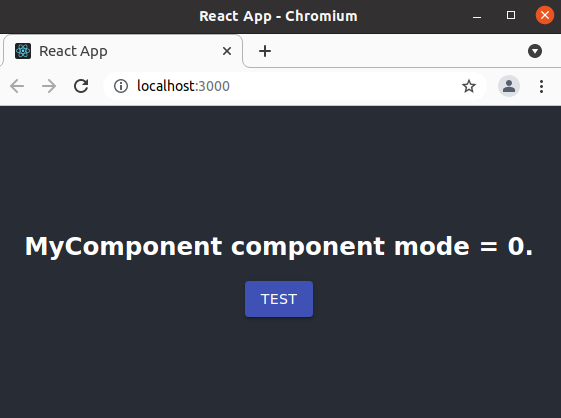How to create a React component
井民全, Jing, mqjing@gmail.com
Here, I'll show you a 3-steps procedure to create a React component. It also includes the responses for the following basic questions:
如何寫一個 React Component, 當改變它的狀態時, 連帶改變顯示狀態 (How to create a React Component, and How to automatically update the component render state when its state was changed?)
=> use setState.
如何呼叫 component method, 更改自身的 status, 並且連動改變顯示狀態? (How to invoke a sub-component method to update its state?)
=> use Ref.
在 typescript function component 形式的 App, 如何使用 React.createRef(). (How to use React.createRef in function component style tsx source?)
=> let mycomonentElement = React.createRef<MyComponent>(); // in tsx function.
Github: https://github.com/jing-tw/lab-react/tree/master/lab/08-my-component/client
Quick
# Step 1: Create React skeleton npx create-react-app client --template typescript cd client yarn build
# Step 2: Create module vi ./src/mycomonent.tsx File:./src/mycomponent.tsx import React from 'react';
class MyComponent extends React.Component { // (a) Declare the class property for keep the component state state = { // <<<----- must be 'state' mode: 0, }
// (b) Declare a method for updating the compoent state public changeMyComponent = (intMode:number) => { this.setState({ mode: intMode }); };
// (c) Render the component state render() { return ( <div> <h2>MyComponent component mode = {this.state.mode}.</h2> </div> ); } }
export default MyComponent;
|
# Use the component vi: ./src/App.tsx Import the component import MyComponent from './mycomponent;
Create reference let mycomonentElement = React.createRef<MyComponent>();
Connect to the component (in render) <MyComponent ref = {mycomonentElement} />
Invoke your component method (mycomonentElement.current as MyComponent).changeMyComponent0(mode++);
|
Table of Contents
1. Init
2. Create component
2.1. Declare the component
2.2. Another version
3. Usage
3.1. Step 1: Import your component
3.2. Step 2: Link the ref to your component
3.2.1. (a) Create a reference variable
3.2.2. (b) Connect the reference to the component
3.3. Code
4. Install & Build & Run
5. Result
6. Others
6.1. Makeclean
7. References
1. Init
sudo apt-get update sudo apt-get install -y curl git sudo snap install --classic code # vscode
npx create-react-app client --template typescript cd client yarn build |
2. Create component
2.1. Declare the component
Declare the component state directly inside the class[1]. Create a new tsx file for you component.
File:./src/mycomponent.tsx
import React from 'react';
class MyComponent extends React.Component { // Step 1: Declare the class property for keep the component state state = { // <<<----- must be 'state' mode: 0, }
// Step 2: Declare a method for updating the compoent state public changeMyComponent = (intMode:number) => { this.setState({ mode: intMode }); };
// Step 3: Render the component state render() { return ( <div> <h2>MyComponent component mode = {this.state.mode}.</h2> </div> ); } }
export default MyComponent;
|
2.2. Another version
You can also let the MyComponent component itself builds on empty props and the MyComponentState for the state.
File:./src/mycomponent.tsx
// MyComponent has no properties, but the current state is of type MyComponentState // The generic parameters in the Component typing allow passing props // and state. Since we don't have props, we pass an empty object.
type MyComponentState = { mode: number, } class MyComponent extends React.Component<{}, MyComponentState> { // The init function sets the current state. TypeScript will let us know // which ones we are allowed to set. init() { this.setState({ mode: 0 }); }
public changeMyComponent(intMode:number){ this.setState({ mode: intMode }); }
// Before the component mounts, we initialise our state componentWillMount() { this.init(); } render() { return ( <div> <h2>MyComponent component mode = {this.state.mode}.</h2> </div> ); } }
export default MyComponent;
|
3. Usage
Use your component and invoke the Ref method to update state
3.1. Step 1: Import your component
import MyComponent from './mycomponent; |
3.2. Step 2: Link the ref to your component
3.2.1. (a) Create a reference variable
let mycomonentElement = React.createRef<MyComponent>(); |
3.2.2. (b) Connect the reference to the component
return ( <div className="App"> <header className="App-header"> <p> <MyComponent ref = {mycomonentElement} /> </p> </header> </div> );
|
Step 3: Invoke the component method via reference
(mycomonentElement.current as MyComponent).changeMyComponent(2); |
3.3. Code
File: src/App.tsx
import React, { useState } from 'react'; import './App.css'; import Button from '@material-ui/core/Button';
// Step 1: Import your component import MyComponent from './mycomponent;
let mode:number = 0; function App() { // Step 2: Link a local reference to you component for invoking method
// (a): Create a reference variable let mycomonentElement = React.createRef<MyComponent>(); const updateMap = (k:string,v:any) => { setMyMap(new Map(myMap.set(k,v))); }
const onChangeMyComponent = async () => { console.log('onChangeMyComponent') // Step 3: Invoke the component method via reference (mycomonentElement.current as MyComponent).changeMyComponent0(mode++); }
return ( <div className="App"> <header className="App-header"> <p> <MyComponent ref = {mycomonentElement} /> <Button onClick= {onChangeMyComponent} variant="contained" color="primary"> Test </Button> </p> </header> </div> ); }
export default App;
|
4. Install & Build & Run
yarn install yarn build yarn start |
5. Result


6. Others
6.1. Makeclean
# run clean up
The clean script
File:./package.json
"clean": "(rm -fr node_modules; rm -fr build; find . -name \"*.js\" -type f|xargs rm -f; find . -name \"*.map\" -type f|xargs rm -f)" |
7. References
Where to Initialize State in React, https://daveceddia.com/where-initialize-state-react/
TypeScript and React: Render props and child render props, https://fettblog.eu/typescript-react/render-props/